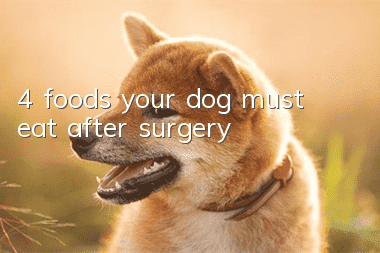Why pets should be neutered? These reasons are enough to convince you!

Four reasons for pet sterilization
1. It can make your quality of life better: Excessive animals make your life without quality of life. No one keeps one. A large group of pets can also treat them consistently.2. Avoid some pain caused by animals in estrus to themselves or others: for example, when a female cat is in estrus, when a female dog is in estrus, many amorous male dogs pee and defecate everywhere, fighting for life... This is very annoying.
3. There are already too many unwanted pets. All we can do is to prevent the number from increasing:Some people say that there are already a lot of cats and dogs, and I am the only one who can keep them. However, thousands of cats and dogs are born every year. If they cannot find suitable owners, they may eventually become stray animals. Who is to blame for the serious problem of stray animals today? If everyone took a responsible attitude and did not let their pets breed, the fate of existing animals would be different. Love them, care for them, and please don't give your pet the chance to give birth to an animal you didn't want it to be born with.
4. Neutering is good for animals: sterilization can prevent animals from creating various problems due to sexual frustration. Owners will not dislike their pets because of those problems, and then have the idea of abandoning them. Therefore, sterilization is good for animals. It's definitely good. In addition, surgery can also prevent the occurrence of certain diseases, such as: pyometra, diseases caused by ovarian cysts, sexually transmitted diseases, prostate enlargement and other problems. Surgery before one year of age can also prevent the occurrence of breast tumors. Sex hormones can cause anxiety in animals, and sexual frustration is a common psychological maladaptive condition, including consequences such as biting, damaging furniture, or bad temper. Neutering can help animals overcome these problems. Neutering certainly has more advantages than disadvantages for animals. General livestock owners’ excuses for opposing sterilization
1. Think your pet is good or has a good pedigree, and want it to maintain an excellent pedigree - in fact, with the attention of its owner, pet animals, regardless of their pedigree, are considerate children. On the contrary, the offspring of a champion family, if not taken care of well, can also breed disgusting rebellion. What's more, gifted parents can also have idiot sons, and heredity isn't always what people want.
2. Male dogs will not give birth to puppies, so there is no need for sterilization - the trouble caused by male hormones is no less than the trouble of childbirth. Male dogs will continue to look for someone to mate with and problems will arise. For example, fighting with other male dogs due to jealousy, car accidents or injuries when staying on the road, attacking other weak animals when emotionally unstable, etc. If you force a sexually driven male dog to stay in the house, he may destroy furniture or bite people. In addition, barking or losing his temper are common symptoms of sexual frustration. Sex drive can turn a cute dog into a nasty one.3. I think it is enough to take good care of the pet when it is in heat, and there is no need to sterilize it - a female dog goes into heat twice a year after becoming sexually mature, and one time lasts for about 3 weeks. This kind of heat phenomenon lasts for about 10 days without sterilization.for many years. Not only do female dogs dirty the environment when they are in heat, but there are often groups of male dogs outside the door, and they can get pregnant if they accidentally sneak out. A wise saying passed down by friends who care about animals is, "Finding a suitable adoptive family for a puppy is more difficult than finding a parking space on the streets of Taipei." To prevent the birth of unnecessary little lives, surgery is safer. Leaving aside the problem of pregnancy, female dogs have various strange phenomena of false pregnancy after menstruation, and problems of pyometra and breast tumors in old age. These problems are all problems that can be completely prevented after birth control surgery.
4. Consider sterilizing nature – yes. But keeping them like pets is also unnatural. For example, it is unnatural to teach a dog to sit, to keep a cat at home, or to artificially breed a particular breed.
5. Want to make money by breeding puppies - There are a lot of expenses involved in raising pets, such as breeding fees, medical expenses for dystocia, etc. In addition, puppies are difficult to care for and may die young. Even if they have gone through a lot of hard work to raise them enough to be sold for money, most people don’t have the channels to raise them until they can no longer be sold. This is how many livestock owners raise too many pets. I advise you to avoid using animals to make money unless you are engaged in breeding. You will usually lose more than you make.6. Believe that sterilization will make animals fat - it is not the sterilization surgery that makes animals obese. The main cause of obesity is overfeeding and lack of exercise by livestock owners. However, neutered animals are generally lazy to move around. It is recommended to feed them less food than before and take them for more exercise. For example, guide dogs must be neutered during formal training, but none of them has ever been overweight.
7. Worry about big changes in temperament after sterilization - female animals will not change at all, while male animals will have some good changes, such as becoming docile.
8. Worry about the risk of anesthesia or infection after surgery - this is a routine minor surgery, trained under the surgeon's knife. Under complete anesthesia, the animal will not feel pain, the wound is not large, and the animal will fully recover within 2-3 days. The damage won't be great.
9. Some people think that it is better for female animals to have one child. This is just nonsense. There is no reasonable reason why it is better for animals to have one child. What's more, pregnancy and childbirth inherently involve unnecessary risks, so why is it better to have one child?10. The pet is already pregnant and thinks the operation is inhumane or unsafe - whether sterilization during pregnancy is humane or not depends on Just like people's concept of whether abortion is humane or not, it all depends on people's thoughts and there is no final conclusion. Some veterinarians are also reluctant to perform this type of surgery. But I personally think that rather than leaving them unable to be cared for after birth and letting these little animals become a neglected group or possibly become stray animals, it is better to choose surgery as a humane option. This type of surgery only requires the doctor to be extra cautious when tying blood vessels to prevent continued bleeding. In fact, it is not particularly unsafe, so there is no need to panic.
11. There are some animal conditions that owners consider unsuitable for surgery, such as being too young, too old, overweight, debilitatedWeak, sick or animals in heat. Current medical research shows that early neutering of dogs does not cause any hormonal imbalance, affect bone development, or predispose to skin diseases, so young age is not a reason why surgery is impossible. Anesthesia should be given with special attention in animals that are old, sick, or overweight, but in which surgery is not possible. Animals in estrus are more likely to bleed, but the ovarian ligaments are loose and surgery is relatively easy, so there is no need to operate.
12. Some people think that male animals will lose their virility after sterilization, dogs will no longer guard the door, and cats will no longer hunt mice. This is nonsense. These qualities of animals are innate and are used by people. Male dogs have their territorial nature, so they will guard the door; cats regard mice as prey, so they will hunt mice. It has nothing to do with sterilization or not. Many working dogs in Europe and the United States have been neutered, which does not affect their functions.Common diseases of unneutered animals
1. Pyometra: Most occur in old dogs over 7 years old, and the incidence rate is quite high in unneutered elderly female dogs. This disease often only has symptoms of frequent thirst and frequent urination when it first occurs. If it is not an open type with a large amount of secretions, the owner will not pay much attention. If it is delayed for a long time, the body tissues will be damaged due to the absorption of bacterial endotoxins, and in severe cases, it may lead to kidney failure, which cannot be treated. Atretic pyometra that cannot drain out will cause peritonitis when the uterus ruptures due to collision or excessive pus, which can quickly lead to death. In addition, the risk of anesthesia for old and sick dogs is high, and the cost of surgery and postoperative care is much higher than that of normal sterilization. Therefore, animals that are not planned to be bred are best sterilized as soon as possible.2. Endometritis: After estrus, due to hormonal factors, the uterus is prone to infection. A small amount of secretion can be seen clinically, which can be controlled with medication. However, animals with this type of system can easily become cases of pyometra infection and require surgical removal. It is a once and for all solution.
3. Breast tumors: A common disease in older animals that have not been neutered. About 50% of dogs are malignant tumors. Once it occurs, the chance of recurrence after removal is quite high. According to literature reports, the causes of this type of disease are related to hormones, and animals neutered before one year old are almost unlikely to develop it.
4. Ovarian cyst: Animals will have continuous estrus, and some animals will have vaginal hyperplasia. Surgery to remove the ovaries can solve the problem.
5. Sexually transmitted diseases: Most are infected through mating. Sexual organ infection caused by mating, oral infection caused by licking diseased tissue, skin infection caused by wound contact, nasal infection caused by inhalation of tissue, and even brought into the abdominal cavity by surgical contamination... The animals have a bloody stench and are extremely uncomfortable.
6. Prostate enlargement: A common disease in elderly male dogs, which manifests as abdominal pain, difficulty urinating, and even hematuria. The treatment is to sterilize to block male hormones and allow the glands to shrink naturally. Prevent the occurrence of this disease and eliminate the possibility of prostate tumors.
7. False pregnancy: Some female dogs will lactate and make nests after going into estrus, and they seem to be pregnant and about to give birth. This is a pathological reaction of hormonal abnormalities. If it happens frequently, only sterilization can prevent it.
8. Testicular tumors: When unneutered male animals with cryptorchidism age, the testicles that have not dropped to the testicle often turn into tumor tissue, and cryptorchidism itself is hereditary, so it is recommended to treat such animals Animals are neutered.
Sterilization methods and precautions
1. Male animals: remove the testicles, which is called castration surgery (Castration)
2. Female animals: remove the uterus and ovaries Complete excision (OHE)
3. Appropriate timing of sterilization: But as long as the immunity is complete and the body is fine, the operation can be performed.
4. If you have already decided, please contact a reliable animal hospital in advance;
5. Arrange a time for your pet to be operated on when your work is not stressful and you have time to take care of it after the operation;
br />6. Food and water should be fasted for 6-8 hours before surgery to prevent foreign objects from entering the respiratory tract during vomiting during or after surgery;
7. Do not rush to let it eat after surgery. Gastrointestinal motility is slow after anesthesia. , eager to eat may cause gastroenteritis symptoms;
8. After surgery, you should limit excessive strenuous exercise, climbing stairs, and overeating, and do not take a bath until the wound is completely healed (about 10-14 days).
9. During the wound healing process, if blood is found oozing out of the wound, it may be that the wound has collapsed, and you need to go to the hospital for follow-up consultation.
- Can dogs eat cowpeas?
- Can dogs eat donkey meat?
- How many meals do dogs eat a day?
- How to feed an Australian Terrier
- Are French Dou born without tails?
- Are dogs afraid of the cold? Maybe the answer is different from what you think
- A complete list of beauty and care methods for poodles
- Reasons why dog training fails
- What to do if your dog’s nails bleed after being cut
- How long does it take for a dog to die if its throat is stuck?



